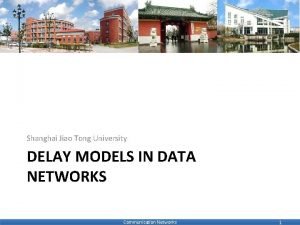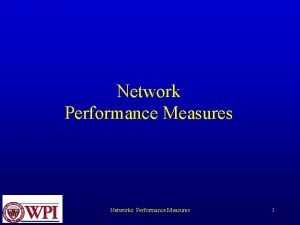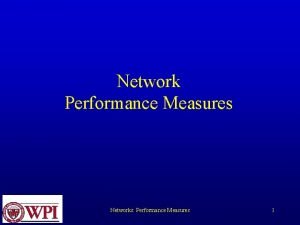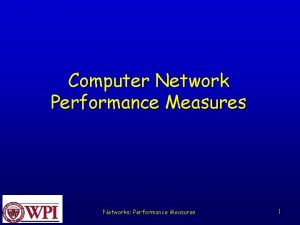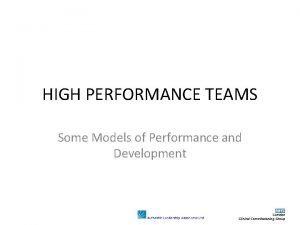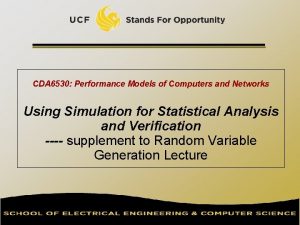CDA 6530 Performance Models of Computers and Networks











![Simulation result (100 time steps) q q bar([Pi_theory Pi_simulation]); Pi_theory and Pi_simulation are column Simulation result (100 time steps) q q bar([Pi_theory Pi_simulation]); Pi_theory and Pi_simulation are column](https://slidetodoc.com/presentation_image_h2/e7d8c476d48fa7aea707058cf04424e3/image-12.jpg)



- Slides: 15

CDA 6530: Performance Models of Computers and Networks Chapter 8: Statistical Simulation --Discrete-Time Simulation

Simulation Studies q Models with analytical formulas q Calculate the numerical solutions q Differential equations ---- Matlab Simulink q q q Discrete equations --- program code to solve The mean value formulas for stochastic events q q Or directly solve if has closed formula solutions Solutions are only for the mean values If you derive models in your paper, you must use real simulation to verify that your analytical formulas are accurate 2

Simulation Studies q Models without analytical formulas q Monte Carlo simulation Generate a large number of random samples q Aggregate all samples to generate final result q Example: use U(0, 1) to compute integral q q Discrete-time simulation Divide time into many small steps q Update system states step-by-step q Approximate, assume system unchanged during a time step q q Discrete event simulation (DES) Accurate q Event-driven q 3

Discrete-Time Simulation q System is assumed to change only at each discrete time tick Smaller time tick, more accurate simulation for a continuous-time physical system q At time k, all nodes’ status are only affected by system status at k-1 q q Why use it? Simpler than DES to code and understand q Fast, if system states change very quickly (or many events happening in short time period) q 4

Discrete-Time Simulation While (simulation not complete){ 1). Time tick: k ++; 2). For system’s node i (i=1, 2, ) 3). Simulate what could happen for node i during the last time step (k-1 k) based on all nodes status at k-1 4). Update the state of node i if something happens to it 5). Output time tick k’s system’s states (e. g. , status of every node in the system) } 5

Discrete-Time Simulation q Note: when computing system node i’s state at time tick k, it should be determined only by all other system nodes’ states at time tick k-1 q Be careful in step 4): DO NOT use node j’s newly updated value at current round q Newly updated value represents state at the beginning of next round. 6

Discrete-Time Simulation q An example: one line of nodes q Xi(t)= (U-0. 5) + (Xi-1(t-1) + Xi+1(t-1)) / 2 Simul_N = 1000; n=100; X = ones(n, 1); for k=1: Simul_N, U = rand(n, 1); X(1) = (U(1) - 0. 5) + X(2); for i=2: n-1, X(i) = (U(i) - 0. 5) + (X(i-1) + X(i+1)) / 2; end X(n) = (U(n) - 0. 5) + X(n-1); % display or save X value for time k end What’s Wrong? 7

Discrete-Time Simulation Corrected Code: q Simul_N = 1000; n=100; X = ones(n, 1); Prior_X = ones(n, 1); for t=1: Simul_N, U = rand(n, 1); Prior_X = X; /* save last time’s data */ X(1) = (U(1) - 0. 5) + Prior_X(2); for i=2: n-1, X(i) = (U(i) - 0. 5) + (Prior_X(i-1) + Prior_X(i+1)) / 2; end X(n) = (U(n) - 0. 5) + Prior_X(n-1); % display or save X value for time k end 8

q q Another way to do the correct coding: Simul_N = 1000; n=100; X = ones(n, Simul_N); % X(i, t) is the value of node i at time t. for t=2: Simul_N, U = rand(n, 1); X(1, t) = (U(1) - 0. 5) + X(2, t-1); for i=2: n-1, X(i, t) = (U(i) - 0. 5) + (X(i-1, t-1) + X(i+1, t-1)) / 2; end X(n, t) = (U(n) - 0. 5) + X(n-1, t-1); % display or save X value for time k end 9

Example: Discrete-Time Markov Chain Simulation Simulate N steps q For each step, use random number U to determine which state to jump to q q q Similar to discrete r. v. generation ¼(i) = mi/N N: # of simulated steps q mi: number of steps when the system stays in state i. q 10

Discrete-time Markov Chain Example 0 q q 1 Markov on-off model (or 0 -1 model) Q: the steady-state prob. ? 11
![Simulation result 100 time steps q q barPitheory Pisimulation Pitheory and Pisimulation are column Simulation result (100 time steps) q q bar([Pi_theory Pi_simulation]); Pi_theory and Pi_simulation are column](https://slidetodoc.com/presentation_image_h2/e7d8c476d48fa7aea707058cf04424e3/image-12.jpg)
Simulation result (100 time steps) q q bar([Pi_theory Pi_simulation]); Pi_theory and Pi_simulation are column vectors 12

Appendix: Continuous R. V. simulation q Use inverse transform method: q q q One value of U one r. v. sample Normal distr. use the polar method to generate How to draw CDF? Problem: r. v. x could be any value q Solve: determine xi points to draw with fixed interval (i=1, 2, …) q F(xi) = P(X· xi) = m/n q n: # of samples generated q m: # of sample values · xi q 13

Continuous R. V. q How to draw pdf (probability density function)? q In Matlab, use histc() and bar() N = histc(Y, Edge) for vector Y, counts the number of values in Y that fall between the elements in the Edge vector (which must contain monotonically nondecreasing values). N is a length(Edge) vector containing these counts. q Use bar(Edge, N, ‘histc’) to plot the curve q q The curve plot will have the same curve pattern as f(x), but not the same Y-axis values 14

Pdf example of continuous R. V. % exponential distribution pdf lambda = 2; sample. N = 1000; Sample = zeros(1, sample. N); U = rand(1, sample. N); for i=1: sample. N, Sample(i) = -log(1 -U(i))/lambda; end Edge = 0: 0. 1: 5; N = histc(Sample, Edge); bar(Edge, N, 'histc'); 15
 Difference between datagram and virtual circuit switching
Difference between datagram and virtual circuit switching Basestore iptv
Basestore iptv Modals and semimodals
Modals and semimodals Delay models in data networks
Delay models in data networks Network performance measurement in computer networks
Network performance measurement in computer networks Network performance measurement in computer networks
Network performance measurement in computer networks Router node
Router node Performance metrics in computer networks
Performance metrics in computer networks Network performance measurement in computer networks
Network performance measurement in computer networks Team performance models
Team performance models Ainsworth experiment
Ainsworth experiment Performance management vs performance appraisal
Performance management vs performance appraisal Behaviorally anchored rating scale
Behaviorally anchored rating scale 2018 jcids manual
2018 jcids manual Repetititon
Repetititon Competency statement 1 cs i b
Competency statement 1 cs i b



